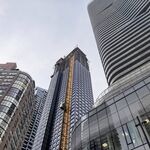Dan416
Senior Member
I find it odd that this thread has degenerated into talk about BRT. The thread title is Save Our Subways! Although in the same way the SELRT thread has degenerated into a subway vs LRT thread. And many other examples.
Um, what? The bus does not have to leave the HOV lane to pick up passengers on Don Mills...
Sounds quite obvious to me you have never used the Don Mills bus, or even seen it.
There has to be a delicate balance though. Yes, smaller stations are cheaper, but there are certain stations along the line that need to be bigger. St. George is a perfect example of a station that, in light of the current passenger demands, was underbuilt. Determine which stations along the route will be stations that handle a large amount of people (transfer stations, stations that connect to major bus/BRT/LRT routes, etc), and build them a bit bigger. But keep the less-used local stations (like Glencairn, Rosedale, Runneymede, etc) smaller to save on cost.
I don't consider streetcars a total failure. I mean, they're great for tourists if you have nowhere to be and don't mind plodding along.
I find it odd that this thread has degenerated into talk about BRT. The thread title is Save Our Subways! Although in the same way the SELRT thread has degenerated into a subway vs LRT thread. And many other examples.
I find the HOV on Don Mills (at least) is fairly well respected, and does move quite well. Buses on that road with HOV don't get stuck in traffic the same way as they used to in the 1980s. And as for rush-hour only ... that's still 7 hours a day! Outside of those hours I find the bus is actually faster anyways, because there is less traffic, and less users. The one problem I've noticed is that the HOV hours on Pape are shorter than the rest of the route, and the bus really slows around 6 pm with all the parked cars.Lack of enforcement in the existing HOV lanes causes major delays at peak hour and remember that the curb lanes are designated for HOV’s during the weekday a.m. and p.m. peak periods ONLY, it's not a 24/7 transit ROW.
Remember when SaveOurSubways was KeithZ and Second in Pie and CC making generally nuanced and balanced arguments against TC lines and not Fresh Start making grandiose speeches about the wonders of THE BUS like he's Bill Pullman at the end of Independence Day and streetcars are those gross alien things?
The layout of St. George is very efficient, and capable of handling massive volumes of people. The problem there, as well as at Yonge-Bloor, is that there are more people trying to use the station than there are spots on the train. No amount of stairs, corridors, or concourse levels would reduce the number of displaced passengers waiting on the platform.
The funneling effect of having the entire city of Toronto pass through just 2 subway stations is the culprit. It means that more people use Bloor-Yonge station - 197,000 per day, than Times Square Station - 189,000 per day. Bloor-Yonge is served by 2 subway lines, Times Square is served by 5 or 12 depending on what definition you use.
Yep, Toronto tends to build huge lines in small numbers. A city like Madrid, on the other hand, builds many lines (12 at last count), with each one being much smaller. Most of their trains are much shorter than in Toronto, probably only a third of the length. Because of that stations are a lot smaller. Many of them don't have big mezzanines, and most have side platforms instead of centre platforms. But trains are very frequent, and the subway lines are absolutely everywhere so congestion is dispersed and the trains are busy but not super packed. The only really big stations are interchange stations, and even some of them are small. While Toronto may not need 12 subway lines, it would probably be better served with many lines built to a lower standard.There has to be a delicate balance though. Yes, smaller stations are cheaper, but there are certain stations along the line that need to be bigger. St. George is a perfect example of a station that, in light of the current passenger demands, was underbuilt. Determine which stations along the route will be stations that handle a large amount of people (transfer stations, stations that connect to major bus/BRT/LRT routes, etc), and build them a bit bigger. But keep the less-used local stations (like Glencairn, Rosedale, Runneymede, etc) smaller to save on cost.
Yep, Toronto tends to build huge lines in small numbers. A city like Madrid, on the other hand, builds many lines (12 at last count), with each one being much smaller. Most of their trains are much shorter than in Toronto, probably only a third of the length. Because of that stations are a lot smaller. Many of them don't have big mezzanines, and most have side platforms instead of centre platforms. But trains are very frequent, and the subway lines are absolutely everywhere so congestion is dispersed and the trains are busy but not super packed. The only really big stations are interchange stations, and even some of them are small. While Toronto may not need 12 subway lines, it would probably be better served with many lines built to a lower standard.
BTW, we tend to do the same thing with highways - huge rights of way with big medians, shoulders, and interchanges but we don't have very many of them.
My position has never wavered although I have come to accept some unavoidable realities going forth, and I never said that I speak on behalf of the group. Streetcars have their place admittedly; just not along key transit corridors like Eglinton, Sheppard East nor the path to SCC from Kennedy Stn. I'm just stepping up my A-game because the misconceptions the LRT advocates and pundits have been spewing all over the internet and the media unchecked for some years now, has got to be reigned in. No one else seems brave enough to rattle the cage, question authority; so I'm just doing my little bit to encourage readers of this forum to educate themselves. Analyse the TTC's track record with all three modes: streetcars, express bus routes and metro subways and then ask themselves which modes are most notorious for delays, which run more efficently, and how dedicated transit-only ROWs would the operation of said modes operate that much better for the least expenditure.
Most of what you're saying is irrelevant, because you're never going to sell the voting public on more buses as something to get excited about. Transit infrastructure with rails increases property values and gets voters fired up for candidates. It's why 'rapid transit through every ward' is such a critical part of Transit City, even if you'll disagree on the 'rapid' part.
In addition, basically concluding that the only mode of transit the TTC is capable of running well is subways is incredibly defeatist. And kind of wrong, considering that the TTC hasn't even done a great job of running the subway lately. Regardless of what shape current expansion and construction projects take, line mismanagement, customer service, etc. are separate issues that need to be addressed NOW.
I think the article in today's Toronto Star might be relevant to the Save Our Subway's thread. Adam Giambrone is set to announce his run in the upcoming mayoral race. I think a mayor such as Giambrone would see as much, if not more, investment in public transit then we saw under David Miller- who was also transit friendly. Giambrone is not only into transit and is a coucillor that takes many interests in what makes the riding that he is in tick. The reason that I know this is because I am friends with him on Facebook, anyone can be a friend of his (I think that this is a modern way in which he has been campaigning the last few years), and you will see how active he is on community events. Giambrone is young at 32, but has been active in his politacal party for many years. He also speaks more then one language which might help in the very multi-cultural community of Toronto.
The main reason that I would vote for the young Giambrone is that he is pro-transit, in fact I have seen him on a street car once when I was exploring my newly adopted city a few years ago. I also hope that Joe Mihevic, the TTC vice-chair becomes the chair of the TTC. I was at the TTC meeting, Giambrone was away on business, and Mihevic announced the TransitCity Plan. His enthusiasm was contagious, and I am sure he would also push for more subways as well as the streetcars and LRT that he promotes
I was hoping Giambrone was going to enter the race- I think if he was elected he might be able to convince the feds and province to invest in the transit infrastructure here in Toronto and that would spark similar investments all around the GTA as well. This could become a true transit oriented city under his leadership. Giambrone isn't perfect, no one is, but I think that transit investment would increase significantly if he were elected. I hope that the Bloor/Danforth line gets extended at both termini like the YUS subway line is getting. I strongly feel that the subway should get closer to Peel region, even more so then York Region.




